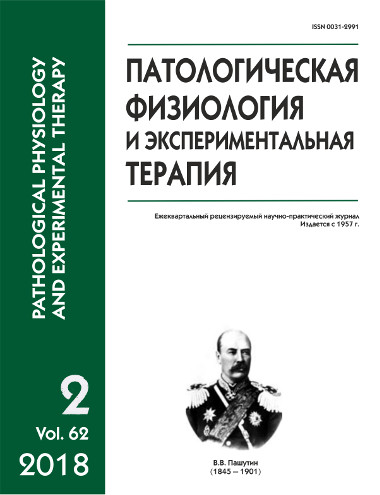Angiogenic vitalization of biocompatible and biodegradable scaffold (in vivo experimental study)
Abstract
The aim of the study was to evaluate the effect on angiogenesis of a biocompatible, biodegradable material-derived scaffold implanted into rats and functionalized using a plasmid with a vascular growth factor gene. Methods. Experiments were performed on 24 female Wistar rats aged 2 months weighing 180-200 g. We investigated 1 cm x 1 cm flat scaffolds obtained by electrospinning from polycaprolactone functionalized scaffolds with a VEGF-165 plasmid (gene therapy drug, Neovasculgen) incorporated inside the fibers at two concentrations, low (0.005 mg/ml) and high (0.05 mg/ml). The sample and control were simultaneously implanted subcutaneously into two formed symmetrical pockets in the interblade zone. At 7, 16, 33, 46, and 64 days, the scaffolds were removed, and histological examination was performed; the tissue reaction was studied including morphometric evaluation of density and diameter of blood vessels in the implantation area, and the area of the image occupied by the material was measured. Results. Tissue rejection was absent after implantation of either control or modified material. When the material was exposed in vivo, besides resorption of the material, blood vessel number and diameter changed. As the Neovasculgen concentration in samples increased, a dose-dependent effect of angiogenesis stimulation became evident. Vascular density was increased by 46% (high concentration, 33 days) in functionalized matrices compared to the control. After cessation of the drug treatment, the vascular density approached the control values. Conclusion. The developed technique for functionalizing polymeric scaffolds by administration of a solution of the gene therapy drug, Neovasculgen, into microfibers provides a prolonged and dose-dependent effect on growth of blood vessels in the implantation zone.
Downloads
References
2. Dmitrieva L.A., Pivovarov Yu.I., Kurilskaya T.E., Sergeeva A.S. Modern state of problem of delivery of medicines with use of erythrocytes as cell-carriers. Journal of Pathophysiology and Experimental Therapy. 2016; 60(3): 88-94. (In Russian)
3. Sevostyanova V.V., Matveeva V.G., Antonova L.V., Velikanova E.A., Shabaev A.R., Senokosova E.A., et al. Constructing a blood vessel on the porous scaffold modified with vascular endothelial growth factor and basic fibroblast growth factor. AIP Conference Proceedings. 2016; 1783: 20204.
4. Del Gaudio C., Baiguera S., Ajalloueian F., Bianco A., Macchiarini P. Are synthetic scaffolds suitable for the development of clinical tissue-engineered tubular organs?. Journal of biomedical materials research. Part A. 2014; 102(7): 2427-47.
5. Antonova L.V., Sevostyanova V.V., Kutikhin A.G., Mironov A.V., Krivkina E.O., Shabaev A.R., et al. Vascular endothelial growth factor improves physico-mechanical properties and enhances endothelialization of poly(3-hydroxybutyrate-co-3-hydroxyvalerate)/poly(e-caprolactone) small-diameter vascular grafts in vivo. Frontiers in Pharmacology. 2016; 7: 230.
6. Antonova L.V., Seifalian A.M., Kutikhin A.G., Sevostyanova V.V., Matveeva V.G., Velikanova E.A., et al. Conjugation with RGD Peptides and Incorporation of Vascular Endothelial Growth Factor Are Equally Efficient for Biofunctionalization of Tissue-Engineered Vascular Grafts. International Journal of Molecular Sciences. 2016; 17(11): 1920.
7. Simón-Yarza T., Formiga F.R., Tamayo E., Pelacho B., Prosper F., Blanco-Prieto M.J. Vascular Endothelial Growth Factor-Delivery Systems for Cardiac Repair: An Overview. Theranostics. 2012; 2(6): 541–52.
8. Wissing T.B., Bonito V., Bouten C.V., Smits A.I. Biomaterial-driven in situ cardiovascular tissue engineering—a multi-disciplinary perspective. npj Regenerative Medicine. 2017; 2(1): 18.
9. Grigorian, A.S., Schevchenko K.G. Some possible molecular mechanisms of VEGF encoding plasmids functioning. Cellular Transplantation and Tissue Engineering. 2011; 6(3): 24–8. (in Russian)
10. Deev R.V., Drobyshev A.Y., Bozo I.Y., Galetsky D.V., Korolev O.V., Eremin I.I., et al. Construction and biological effect evaluation of gene-activated osteoplastic material with human VEGF gene. Cellular Transplantation and Tissue Engineering. 2013; 8(3): 78-85. (in Russian)
11. Lyundup A.V., Demchenko A.G., Tenchurin T.H., Krasheninnikov M.E., Klabukov I.D., Shepelev A.D., et al. Improving the seeding effectiveness of stromal and epithelial cell cultures in biodegradable matrixes by dynamic cultivation. Genes and Cells. 2016; 11(3): 102–7. (in Russian)
12. Tenchurin T., Lyundup A., Demchenko A., Krasheninnikov M., Balyasin M., Klabukov I., et al. Modification of biodegradable fibrous scaffolds with Epidermal Growth Factor by emulsion electrospinning for promotion of epithelial cells proliferation. Genes and Cells. 2017; 12(4): 47-52. (in Russian)
13. Arutyunyan I., Tenchurin T., Kananykhina E., Chernikov V., Vasyukova O., Elchaninov A., et al. Nonwoven polycaprolactone scaffolds for tissue engineering: the choice of the structure and the method of cell seeding. Genes and Cells. 2017; 12(1): 62–71. (in Russian)
14. Zhou J., Zhao Y., Wang J., Zhang S., Liu Z., Zhen M., et al. Therapeutic Angiogenesis Using Basic Fibroblast Growth Factor in Combination with a Collagen Matrix in Chronic Hindlimb Ischemia. The Scientific World Journal. 2012; 2012 (2012): 652794.
15. Dvir T., Kedem A., Ruvinov E., Levy O., Freeman I., Landa N., et al. Prevascularization of cardiac patch on the omentum improves its therapeutic outcome. Proceedings of the National Academy of Sciences. 2009: 106(35): 14990–95.
16. Lemon G., Howard D., Tomlinson M.J., Buttery L.D., Rose F.R.A.J., Waters S.L., et al. Mathematical modelling of tissue-engineered angiogenesis. Mathematical Biosciences. 2009; 221(2): 101–20.
17. Sokolov D.I. Vasculogenesis and angiogenesis in development of a placenta. Journal of obstetrics and woman disease. 2007; 56(3): 129-33. (in Russian)
18. Batyrova A.S., Bakanov M.I., Surkov A.N. Current status of vascular remodeling and angiogenesis in chronic liver diseases. Journal of Pathophysiology and Experimental Therapy. 2016; 60(1): 73–8. (in Russian)






